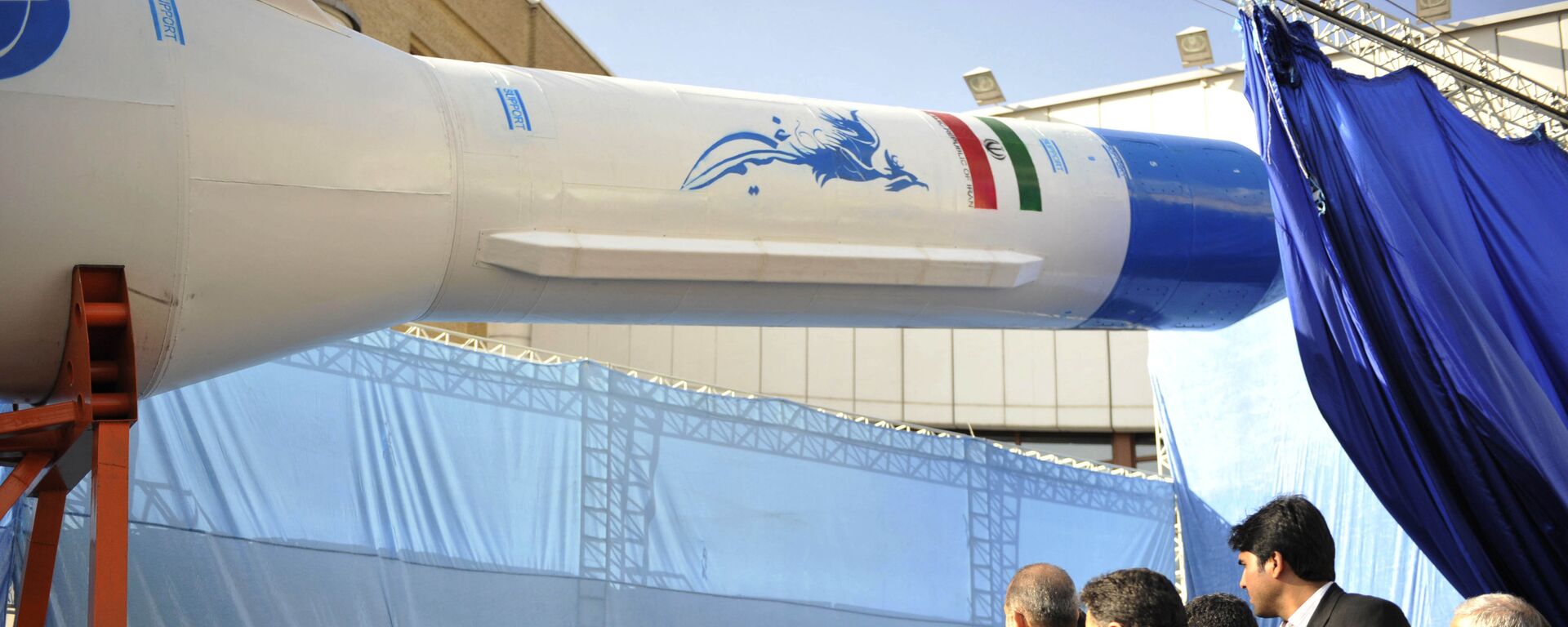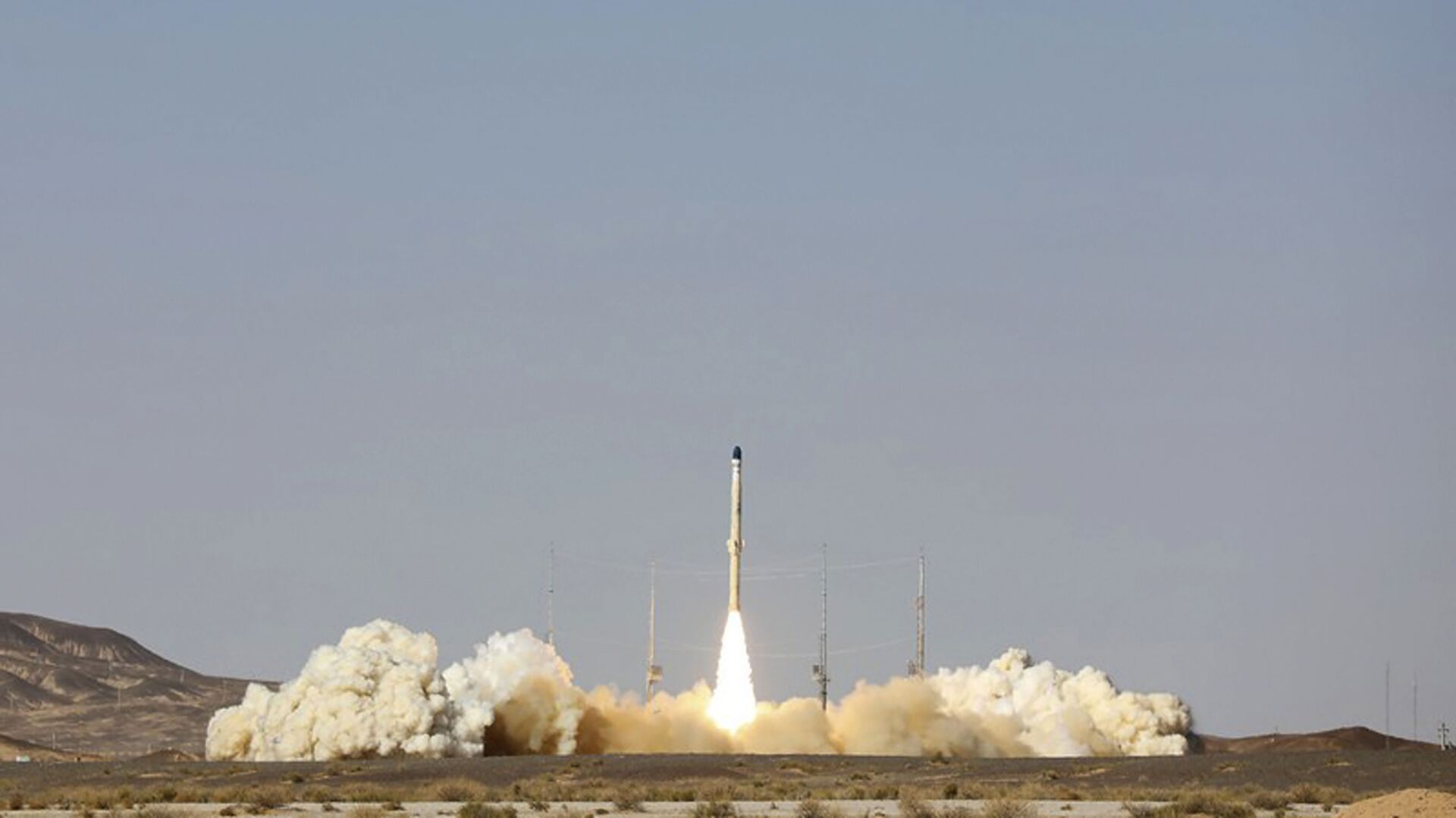https://sputnikglobe.com/20220115/iran-tests-first-solid-fuel-space-rocket-for-cheaper-satellite-delivery-irgc-general-says-1092275881.html
Iran Tests First Solid-Fuel Space Rocket for Cheaper Satellite Delivery, IRGC General Says
Iran Tests First Solid-Fuel Space Rocket for Cheaper Satellite Delivery, IRGC General Says
Sputnik International
A less expensive rocket, however, comes with certain downsides, such as reduced payload weight that the rocket can lift to low-Earth orbit, where most... 15.01.2022, Sputnik International
2022-01-15T10:40+0000
2022-01-15T10:40+0000
2023-04-12T16:57+0000
world
iran
spacecraft
space
https://cdn1.img.sputnikglobe.com/img/07e5/06/0b/1083129678_0:281:3143:2048_1920x0_80_0_0_606e46d27e1aa4eb913cfd2306f03d75.jpg
Iran has succesfully live-tested a solid-fuel engine space rocket, Islamic Revolutionary Guard Corps (IRGC) Aerospace Force Commander, Brigadier General Amir Ali Hajizadeh, stated during an address to religious scholars in the city of Qom. This is the nation's first-ever successful endeavour in the field.The domestically developed and built carrier rocket, Zuljanah, will allow the Islamic Republic to further advance its nascent space programme.Over the past two years, Iranian satellite launches have relied on carriers that use more expensive liquid fuel, Hajizadeh explained. But now, the Islamic Republic can launch new satellites at a lower cost. The IRGC commander did not elaborate on just how much Iran will now save on each launch via the Zuljanah rocket.Zuljanah's solid-fuel engine produces 66-tonne force or 725 kN thrust, which puts the carrier behind Simorgh – a rocket that uses four liquid fuel engines producing up to 1,590 kN thrust. Due to this difference, the solid fuel Zuljanah can lift up to 220 kg of payload versus the 350 kg that Simorgh can carry to low-Earth orbit.Despite the two-fold difference in thrust, Zuljanah still can carry only 37% less payload. General Hajizadeh stated that the recently tested solid-fuel rocket was built using composite materials instead of metals, thus bringing down its weight, saving fuel for lift off, and increasing its overall thrust.Iran is testing several satellite carriers at the moment, having already deployed several satellites into low-Earth orbit. These satellites mainly monitor Iranian territory for agricultural purposes and to detect various hazards, such as wildfires. Iran's Defence Ministry reported last month that it had launched three new satellites via one Simorgh liquid fuel rocket carrier.
https://sputnikglobe.com/20211230/iran-launches-three-new-satellites-into-low-earth-orbit-1091912618.html
iran
Sputnik International
feedback@sputniknews.com
+74956456601
MIA „Rossiya Segodnya“
2022
Tim Korso
https://cdn1.img.sputnikglobe.com/img/07e6/03/0d/1093831826_0:0:216:216_100x100_80_0_0_e3f43a960af0c6c99f7eb8ccbf5f812c.jpg
Tim Korso
https://cdn1.img.sputnikglobe.com/img/07e6/03/0d/1093831826_0:0:216:216_100x100_80_0_0_e3f43a960af0c6c99f7eb8ccbf5f812c.jpg
News
en_EN
Sputnik International
feedback@sputniknews.com
+74956456601
MIA „Rossiya Segodnya“
Sputnik International
feedback@sputniknews.com
+74956456601
MIA „Rossiya Segodnya“
Tim Korso
https://cdn1.img.sputnikglobe.com/img/07e6/03/0d/1093831826_0:0:216:216_100x100_80_0_0_e3f43a960af0c6c99f7eb8ccbf5f812c.jpg
iran, spacecraft, space
Iran Tests First Solid-Fuel Space Rocket for Cheaper Satellite Delivery, IRGC General Says
10:40 GMT 15.01.2022 (Updated: 16:57 GMT 12.04.2023) A less expensive rocket, however, comes with certain downsides, such as reduced payload weight that the rocket can lift to low-Earth orbit, where most satellites are deployed.
Iran has succesfully
live-tested a solid-fuel engine space rocket, Islamic Revolutionary Guard Corps (IRGC) Aerospace Force Commander, Brigadier General Amir Ali Hajizadeh, stated during an address to religious scholars in the city of Qom. This is the nation's first-ever successful endeavour in the field.
The domestically developed and built carrier rocket, Zuljanah, will allow the Islamic Republic to further advance its
nascent space programme."From now on, Iran will be able to launch a great number of satellites using low-cost engines".
Over the past two years, Iranian satellite launches have relied on carriers that use more expensive liquid fuel, Hajizadeh explained. But now, the Islamic Republic can launch new satellites at a lower cost. The IRGC commander did not elaborate on just how much Iran will now save on each launch via the Zuljanah rocket.
Zuljanah's solid-fuel engine produces 66-tonne force or 725 kN thrust, which puts the carrier behind Simorgh – a rocket that uses four liquid fuel engines producing up to 1,590 kN thrust. Due to this difference, the solid fuel Zuljanah can lift up to 220 kg of payload versus the 350 kg that Simorgh can carry to low-Earth orbit.

30 December 2021, 10:42 GMT
Despite the two-fold difference in thrust, Zuljanah still can carry only 37% less payload. General Hajizadeh stated that the recently tested solid-fuel rocket was built using composite materials instead of metals, thus bringing down its weight, saving fuel for lift off, and increasing its overall thrust.
Iran is testing several satellite carriers at the moment, having already deployed several satellites into low-Earth orbit. These satellites mainly monitor Iranian territory for agricultural purposes and to detect various hazards, such as wildfires. Iran's Defence Ministry
reported last month that it had launched three new satellites via one Simorgh liquid fuel rocket carrier.




